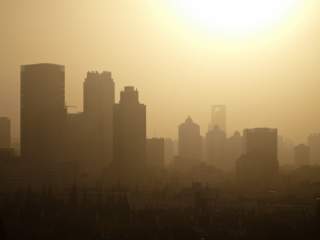China's Climate Change Challenge
"China now emits more tonnes of carbon than the United States and European Union combined."
At the UN Climate Summit this week in New York, Chinese Vice Premier Zhang Gaoli said it all: “China will make greater effort to more effectively address climate change;” announce further actions “as soon as we can;” and achieve “the peaking of total carbon dioxide emissions as early as possible.” According to oneWestern environmental NGO official, “China’s remarks at the Climate Summit go further than ever before. Vice Premier Zhang Gaoli’s announcements to strive to peak emissions ‘as early as possible’ is a welcome signal for the cooperative action we need for the Paris Agreement.” Other media outlets trumpeted: “China pledges to cut emissions at UN climate summit” and “China shifts stance on climate change.”
Really? In the face of such facts as China now emits more tonnes of carbon than the United States and European Union combined (not surprising since it consumes more coal than the entire world put together and its population is greater than that of the United States and EU combined) and, more surprisingly and less understandably, posts higher per capita emissions than the EU, Zhang’s statement seems to be an understatement. Indeed, it amounts to little more than Beijing will do as much as it can whenever it can, without providing any indication of what or when that might be. As Diplomat writer Shannon Tiezzi has noted, China’s biggest actual commitment was to pledge $6 million to promote south-south cooperation on climate change, by any measure a drop in the bucket. How is it that such a vague statement of intent can provoke such positive assessments? Without delving into the reasons that some observers are prone to jump the gun when it comes to applauding China for statements of intent as opposed to observable measures, the real question is whether there are any facts to back up such an optimistic outlook for China’s contribution to meeting the global climate change challenge.
There are indeed some positive signs. As journalist Matt Sheehan has pointed out, both Chinese coal imports and consumption dropped for the first time in a decade, and the country continues to increase the weight of nuclear, solar, wind, and natural gas in the country’s energy mix. The bad news is it isn’t clear whether the drop in coal is primarily from environmental measures to reduce coal consumption domestically (from setting coal caps and deploying tough new fines for coal miners that exceed national production levels) or from slowing Chinese economic growth; if the latter, coal consumption may well rebound if and when the Chinese economy does. Moreover, as Sheehan has reported, the drop in consumption was so slight that some analysts are reluctant to attribute any staying power to it. Also, as China shuts down power plants and coal mining in the eastern provinces, they are planning to move the plants and mines to the country’s western regions. Thus, while some of China’s major coal-related initiatives will do much to improve domestic air pollution in the coastal provinces, they won’t produce the same benefits for climate change.
More good news can be found in China’s efforts to launch a carbon trading exchange in four major cities and two provinces. In fact, Beijing has pledged that it will have a national emissions trading scheme twice the size that of the EU by 2020. Yet as a Stockholm Environment Institute study of China’s carbon emission trading plans detailed in 2012, many obstacles to a well-functioning system remain: measuring emissions more accurately, a legal infrastructure with clearly defined emission rights, permit allocation systems, trading rules, monitoring, and enforcement and accountability. The authors ask the fundamental question: “whether a carbon trading scheme—meant to be a strong market-based instrument—can function well without a mature free market economy.” Or as Australian National University climate expert Frank Jotzo has noted in reference to the Chinese system, “…an emissions trading scheme will be effective only if markets are allowed to work.” Already, concerns have been raised about the functioning of the pilot trading systems. Transparency over historic emissions data on which caps are based; the number of allowances granted; and even the names of companies getting the allowances are not always clear. As one carbon trading expert commented to the Financial Times about China’s carbon market: “It’s a black hole.”
Given the opacity and the complexity of China’s political economy, it is impossible to draw a straight line from Zhang Gaoli’s relatively weak call to climate action and anything that is occurring on the ground in China today. There are three stages to understanding Chinese policy on climate change—or on anything else for that matter: statement of intent, policy design, and policy implementation. The important thing to remember, however, is that in the end, only the last matters.
Editor's Note:This piece first appeared on CFR’s Asia Unbound blog here.
Image: Creative Commons Flickr.

